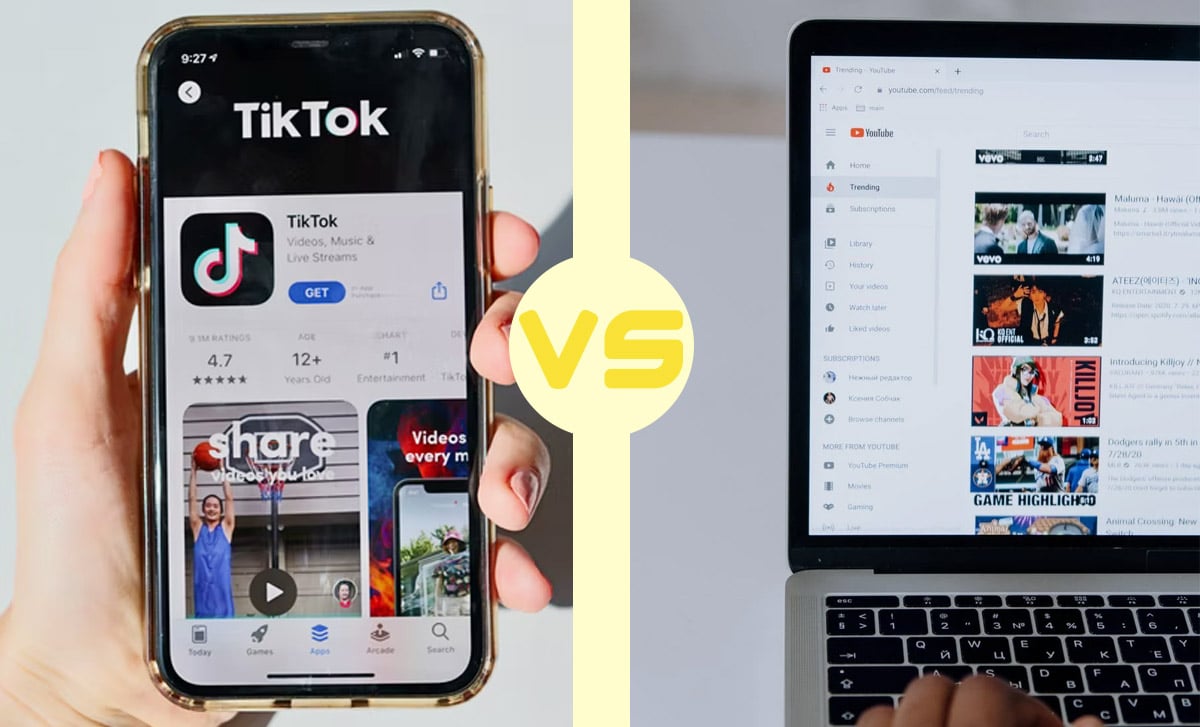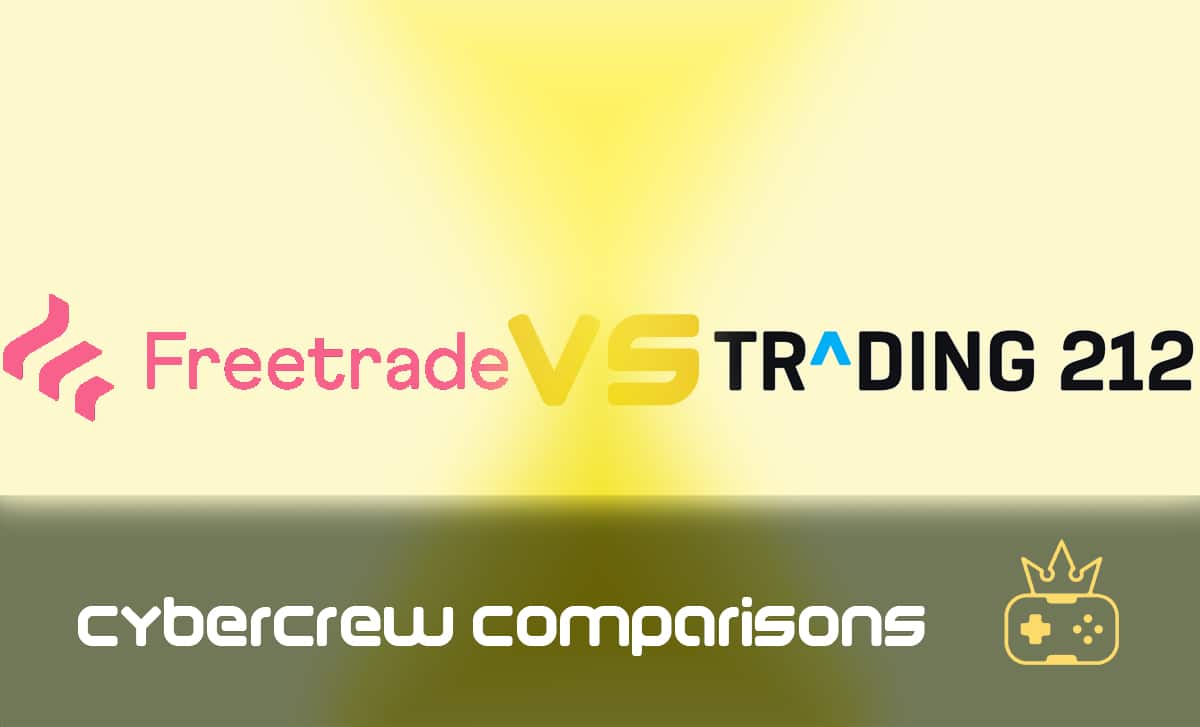YouTube vs TikTok
Last Updated: February 9, 2024
As our attention span decreases, we become more and more addicted to short videos and content that can be consumed in less than 60 seconds. That’s good news for TikTok and its brief yet entertaining videos.
TikTok is today’s young adults’ Instagram. What used to excite us about getting 11 likes on Instagram is the same thing that keeps them buying ring lights and recreating viral dances.
On the other hand, YouTube has remained the OG video sharing platform offering content for literally everyone. I mean, you can find a baby watching cartoons and its grandma watching knitting videos simultaneously.
In this YouTube vs TikTok comparison, we’ll see the similarities and differences these two popular video sharing services have, as well as some fun facts and statistics.
Before we dive in, here are some compelling stats about the two major social media platforms:
- Every minute, 500 hours of video are uploaded on YouTube!
- 35% of the UK population are active YouTube users.
- Almost 5 billion videos are watched on Youtube every single day.
- TikTok has over 3.7 million active users in the UK.
- The total number of hours of video watched on YouTube each month is approximately 3.25 billion.
- The largest share of TikTok users (26%) in the UK is aged 18–24.
- Ed Sheeran had the most popular YouTube channel in the UK with 43 million subscribers and around 18.78 billion views.
- The most active demographic in the UK is people aged 25–44, accounting for 44% of all YouTube users.
- The amount of time spent on TikTok has increased by 210% year-over-year.
- TikTok is downloaded over 1 million times a month in the UK.
What Is YouTube?
YouTube is an American online video-sharing platform founded in 2005 by three former PayPal employees — Chad Hurley, Steve Chen, and Jawed Karim. The idea for YouTube came about when Karim couldn’t find a video of Janet Jackson’s Super Bowl wardrobe malfunction online. Chen and Hurley, however, said the original idea behind YouTube was a video version of an online dating service, which was influenced by the website Hot or Not.
In its early days, YouTube was a simple website where users could upload short videos of up to 10 minutes. These videos were then watched by other YouTube users who could leave comments and rate them.
In 2006, YouTube was bought by Google for $1.65 billion, which gave YouTube the resources it needed to grow and become the powerhouse it is today.
Since then, YouTube has continued to grow and now has over two billion users worldwide. It is the second most popular website in the world after Google, and 79% of internet users have a YouTube account.
YouTube earns its revenue through advertising. It has over 500 hours of video uploaded to the site every minute, and it uses this content to show ads to its users. YouTube also allows users to pay for a monthly subscription that gives them ad-free access to the site.
What Is TikTok?
TikTok is a social media platform that ByteDance owns. It was launched in 2016, and in less than four years, it has amassed over 700 million users.
TikTok is a video-sharing app where users can upload videos that are up to three minutes long (but most of them are less than 30 seconds long). These videos can be about anything — from singing and dancing to challenges and reactions.
TikTok is especially popular with teenagers and young adults, who share creative content and connect globally with friends and like-minded individuals.
Although YouTube was around before TikTok, the latter has quickly become more popular, especially in countries like China, where YouTube is blocked. In fact, TikTok is now the most downloaded app in the world.
TikTok earns its revenue through advertisements and sponsorships. Furthermore, TikTok also has a partnership with Amazon, where users can buy products that they see in videos.
Key Differences
YouTube and TikTok are video-sharing platforms where users can upload and watch videos. They both have a huge user base, with YouTube having two and TikTok over one billion users.
Additionally, TikTok and YouTube are used by many young people, with YouTube being used by 77% of the 15–25 year age group and 50% of TikTok users being younger than 34. Both offer analytics, including video views, watch time, likes, comments, shares, reach and impressions. In addition, both platforms provide features for interactions — likes, comments, replies, subscribe and follow buttons.
However, that’s where the similarities between YouTube and TikTok end. Here are some of the key differences between them:
1. Video duration: If you are verified, your YouTube videos can be up to 12 hours long, or as much as 128 GB. TikTok increased its maximum video time in July when it upped video length from one minute to three minutes.
2. Ownership: TikTok is owned by a Chinese tech company, while YouTube is owned by the search engine giant Google.
3. Premium accounts: TikTok is free to use, and it doesn’t offer a premium plan/account. On the other hand, YouTube has its YouTube Premium option that costs £11.99/month and here’s what it offers:
- Ad-free video
- The option to continue playing videos or music “in the background” (meaning the audio will continue if you minimise the app)
- Music and video downloads
- Access to YouTube original movies and TV shows
- YouTube Music
Content
YouTube is a great place to look for all sorts of content, from music and movies to educational videos and vlogs. You can find videos on just about any topic you can think of, with plenty of channels and users specialising in specific genres.
When it comes to the most popular YouTube channels, they are a clear representation of just how diverse YouTube users are. The top five YouTube channels are a mix of kids’ entertainment, Bollywood, gaming content, and comedy entertainment vlogs.
Table 1. YouTube channels with the most subscribers and types of content they put out
| YouTube channel | Number of Subscribers | Type of Content |
| T-Series | 209 M | Bollywood film’s trailers and music videos |
| Cocomelon – Nursery Rhymes | 130 M | 3D animation videos of traditional nursery rhymes and original children’s songs |
| SET India | 128 M | Compilations/moments from Hindi Sony Entertainment Television’s shows and films |
| PewDiePie | 111 M | Gaming, podcasts, vlogging, collaborations, and more |
| MrBeast | 91.2 M | Comedy entertainment vlogs, gaming reaction |
On the other hand, TikTok is a platform for creative and innovative content creators. For example, users can upload videos of themselves singing, dancing, or doing challenges. There is also a lot of comedy content on the platform, as well as educational videos.
TikTok is mainly used for sharing short videos that are either funny, creative, or inspiring. There is a lot of overlap in terms of the type of content shared on YouTube and TikTok, but the former is more geared towards longer videos while the latter is better for shorter ones.
YouTube tried to stay up to date with the trends and introduced YouTube Shorts — a short-form video sharing platform that limits content to 60 seconds in length. But, as expected, it’s not nearly as popular as TikTok, and you can often find TikTok videos re-shared as YouTube Shorts.
The TikTokers with the most followers are all within the 17–34 age group. The content they put out isn’t as diversified as the one from YouTube’s top five accounts, but people don’t seem to complain.
Table 2. TikTok accounts with most followers and types of content they put out
| TikTok creator | Number of Followers | Type of Content |
| Charli D’amelio | 137.3 M | Dance and choreography videos |
| Khaby Lame | 133.5 M | Silent mocking of overly complicated life hack videos |
| Bella Poarch | 88.1 M | Music and lip-syncing |
| Addison Rae | 86.7 M | Modelling, fashion, music, dance |
| Zach King | 67.5 M | Comedy |
Earnings
YouTube channels can make money in a few ways: through advertisements, sponsorships, and product placements.
Advertising is the most common way for YouTube channels to make money. YouTube partners with several advertising companies that place ads on YouTube videos. The more views a video has, the more money the YouTube channel will earn from the ad. The channel sets up an AdSense account and enables monetisation once creating a YouTube channel. They only get paid once they reach $100 in the AdSense account.
Influencer Marketing Hub says that while payment varies, the average YouTube channel can expect to make about $18 (roughly £13.5) per 1,000 ad views.
Sponsorships are another way for YouTube channels to earn extra cash. A sponsorship is when a company pays a YouTube channel to promote its product or service in one or more of the channel’s videos.
Lastly, product placements are when a company pays a YouTube channel to include their product in one or more videos.
TikTokers make money through gifting, ads, brand partnerships, and merchandise sales.
Gifting means that your TikTok fans buy virtual Coins using real money, which are then used for buying gifts. TikTok is ranked second amongst all apps when it comes to consumer spending. When you go live, your followers can offer you these gifts that convert to Diamonds. Diamonds are used to quantify how popular and appreciated a creator is. Once you make enough Diamonds, you can collect the cash via PayPal or another verified payment service.
Brand partnerships/sponsorship happen if you are popular enough and your following matches a brand’s target audience. Then, the brand will likely pay you to show/review/talk about their products or services. According to Business Insider, you can make an average of $0.01 to $0.02 for each sponsored view on TikTok. So if you have a video with 100,000 views, you can make $1000 (roughly £750) from sponsorships.
Advertisements
YouTube ads are short videos that play before or during a YouTube video. They are used to generate revenue for the YouTube channel owner by advertising for other companies.
There are six types of YouTube ads: skippable, non-skippable, in-feed, bumper, outstream, and masthead ads.
Skippable ads are the most common type of YouTube ad. They are short videos that the viewer can skip after five seconds.
Non-skippable ads are 15 seconds or shorter, and the viewer cannot skip them. They must watch the entire ad before they can watch the YouTube video.
In-feed YouTube ads consist of a thumbnail image from your video with some text. They always invite people to click to watch the video. The video then plays on the YouTube watch page or channel homepage.
Bumper ads are very short (six seconds or less) and non-skippable. Therefore, viewers cannot skip bumper ads, and they must watch the entire ad before they can watch the YouTube video.
Outstream ads begin playing with the sound off. Viewers can tap the ad to unmute the video. Outstream ads are designed to increase your video reach at an efficient cost.
Finally, masthead ads drive awareness for a new product or service or reach a massive audience in a short period of time and are only available on a reservation basis through a Google sales representative.
If you want to advertise a product on YouTube, the cost of the ad will depend on a few factors — watch time, audience targeting, and campaign objective. On average, YouTube advertising costs are from $0.10 to $0.30 per view or action, with an average daily budget of $10 (roughly £7.5), which means every time someone views your ad or engages with your ad, for example, by clicking on a call-to-action, you pay from $0.10 to $0.30.
TikTok Ads offer a powerful and easy-to-use platform that helps businesses and brands reach millions of potential customers. Targeting, ad creation, insight reports, and ad management tools are some of the features TikTok offers for its TikTok Ads users.
Although they aren’t as popular as Facebook or Instagram ads yet, TikTok ads offer an amazing opportunity for a brand to widen its reach. If you want to use TikTok as a marketing tool, go about it by setting up a free TikTok Ads account and creating In-Feed ads with your own set budget and schedule. TikTok’s minimum campaign budget is $500 (£375.6), and the minimum ad group budget is $50 (£37.6).
However, there have been reports that the cost of advertising on TikTok can be anywhere from $50,000 (£37,564.3) to $120,000 (£90,154.20), depending on the type and duration.
Ease Of Use
YouTube is a very user-friendly platform. The layout is easy to navigate, and the videos are easy to watch. You can change your phone to landscape mode and watch your videos on a bigger screen.
Moreover, you can customise your YouTube experience by selecting the channels you want to subscribe to and the videos you want to watch later. You can like videos, search the videos you’ve watched in History, and continue watching the video exactly where you left it off.
Furthermore, YouTube has an algorithm that recommends videos and channels that it thinks you’ll like.
TikTok, on the other hand, is not as user-friendly as YouTube. The layout is not as organised, and it can be challenging to find the videos you are looking for. You can’t search videos by date published or popularity.
In addition, you also cannot customise your TikTok experience in the same way that you can with YouTube. For example, you can save videos to your Favourites folder, but you can’t access your History or watch TikTok videos in landscape mode.
User Base
YouTube has spent over 15 years building its brand and becoming the world’s best video streaming service. In all those years of its existence, it managed to gain a little over two billion users. And then TikTok happened. Within five years of being on the market, it acquired a billion users of its own.
Today, TikTok and Youtube are two of the most popular video sharing services that have to compete head-to-head daily to stay relevant among its shared audience.
Every day, people watch over a billion hours of YouTube videos. Most of them fall in the age group of 15–35.
Table 3. Percentage of YouTube users by gender in the UK
| Female | 46% |
| Male | 54% |
For comparison purposes, here’s the percentage of TikTok users by gender
Table 4. Percentage of TikTok users by gender
| Female | 65% |
| Male | 35% |
Roughly 50% of TikTok’s global audience is under 34, with 32.5% aged between 10 and 19.
An astonishing percentage of users visit the app more than once daily — 90%. Yes, you read that correctly. 90% of TikTok’s one billion users are so loyal (or addicted) that they come back more than one time every day.
Wrap Up
With TikTok taking the world by storm, YouTube gained a mighty competitor in the video platforms industry. As a result, more video content is being created and distributed, with video views skyrocketing.
So, the important question — YouTube vs TikTok: which platform is better? We would have to be diplomatic and say that a different platform would work better for a different person depending on your needs and interests and your free time.
If you find yourself with a short attention span and enjoy shorter videos, TikTok is your app. However, if you want to dive deeper into specific subjects and educate yourself — YouTube videos would help you achieve just that.
FAQ
TikTok videos are up to three minutes long, while YouTube allows creators to post videos up to 12 hours long.
TikTok still has only half as many users as YouTube and is the seventh most used social media platform, while YouTube is the second. So, no, TikTok is not more popular than YouTube.
TikTok has a very different algorithm than YouTube, making it much more likely for your video to get viral.




![How to Sell on Depop in the UK [2024 Guide]](https://cybercrew.uk/wp-content/uploads/2023/06/Selling-on-Depop-UK.png)


![Free Appointment Scheduling Software — UK Top Picks [2024]](https://cybercrew.uk/wp-content/uploads/2022/07/Free-Appointment-Scheduling-Software.png)



